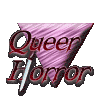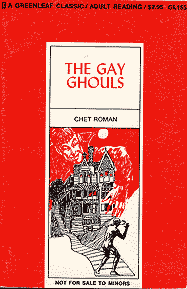
Introduction
The pulp novel reflects the development of queer folk during the
modern GLBT movement. Now mind you, the movement hasn't been
around altogether that long. In America, for example, many consider
the movement to have started in the 1960s, with the defining moment
being the Stonewall Rebellion in 1968. But even within this brief
timespan, queer culture drastically changed.
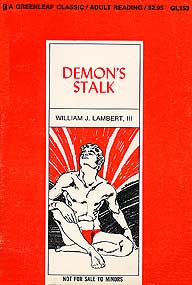 Before and during this time, queer folk had very few places to turn to
support their sexual orientation. One way that they could support
each other, learn more about their sexuality, and see themselves
reflected as 'normal' was in pulp novels. Pulps were cheaply printed
books that began to appear in the 1940s. The hope of the printers
was to get great works of literature out to the masses. But, instead
of making these works more readily available, they served as a way
to spread trash, often with no discernable plot lines and with two-dimensional
characters. Books so poorly written that no publisher would
touch them now had an audience.
Before and during this time, queer folk had very few places to turn to
support their sexual orientation. One way that they could support
each other, learn more about their sexuality, and see themselves
reflected as 'normal' was in pulp novels. Pulps were cheaply printed
books that began to appear in the 1940s. The hope of the printers
was to get great works of literature out to the masses. But, instead
of making these works more readily available, they served as a way
to spread trash, often with no discernable plot lines and with two-dimensional
characters. Books so poorly written that no publisher would
touch them now had an audience.
The heyday of pulps for queers started in the late 1960s, and continued
through the 70s; and all sexualities were represented. Lesbians appeared
most frequently, but generally as a way to titillate heterosexual men,
rather than lesbian women. But, some of the stories were written by women
for women. In addition, many gay, bisexual and even transgender stories
were also written.
The Demon Within
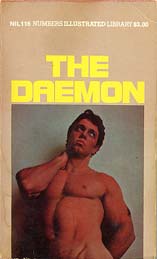 The earliest of the queer horror pulps gives those of us used to a more
modern, gentler time and idea of what those who came before us had
to deal with. Many of the pulps begin as though they are addressing
an audience ready to lynch them. The forewords often times explaining
why GLBT folks weren't inherently evil and how they needed to learn
to stand up for themselves and fight back. Many others, however,
gave the impression that gay life was a sad, empty, cruel and meaningless
life. Too often they refer to 'twilight lovers', 'strange men' and
'hidden evil' when describing queers.
The earliest of the queer horror pulps gives those of us used to a more
modern, gentler time and idea of what those who came before us had
to deal with. Many of the pulps begin as though they are addressing
an audience ready to lynch them. The forewords often times explaining
why GLBT folks weren't inherently evil and how they needed to learn
to stand up for themselves and fight back. Many others, however,
gave the impression that gay life was a sad, empty, cruel and meaningless
life. Too often they refer to 'twilight lovers', 'strange men' and
'hidden evil' when describing queers.
An all-too-common theme in many of the forewords of these books is in
challenging the new field of 'psychology.' During this time, queer folk
were labeled as aberrant, deviates and psychosexual. With a new terminology
and the label of 'science' to back it up, psychology threatened to continue
the persecution of homosexuals that religion had begun.
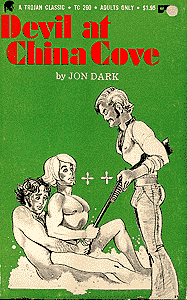 In doing research for this article, I found it increasingly difficult
to figure out what pulps would have horror contents. Some
were fairly easy to pick out, such as
Three on a Broomstick
by Don Holliday in 1967 and
Gay Vampire
by Davy S. [pseudonym] in 1969. And many were easy to automatically dismiss with
names such as Raunchy Truckers or Daddy's Little Boy.
But a large number of pulps fell somewhere in between. Black
Room Terror, Deliver Her To Evil, The Evil Friendship
and dozens of other titles caught my eye as having potential.
It became obvious that instead of finding pulps that dealt with
GLBTs in horror, I discovered a time period where GLBT folk were
the horror.
In doing research for this article, I found it increasingly difficult
to figure out what pulps would have horror contents. Some
were fairly easy to pick out, such as
Three on a Broomstick
by Don Holliday in 1967 and
Gay Vampire
by Davy S. [pseudonym] in 1969. And many were easy to automatically dismiss with
names such as Raunchy Truckers or Daddy's Little Boy.
But a large number of pulps fell somewhere in between. Black
Room Terror, Deliver Her To Evil, The Evil Friendship
and dozens of other titles caught my eye as having potential.
It became obvious that instead of finding pulps that dealt with
GLBTs in horror, I discovered a time period where GLBT folk were
the horror.
In 1970, three pulps were published in the queer horror genre.
The Gay Haunt by Victor Jay,
The Gay Ghouls by Chet Roman and
Demon's Stalk by William J. Lambert, III
had very different storylines, but remarkably similar thought processes behind
them. In reading them, you could feel the authors trying to
break away from their own self-hating attitudes, but never completely
succeeding. The gay folk in these stories were sexually depraved,
sure, but they also desired relationships. And even though
"a relationship" didn't actually mean monogamy (this was pre-AIDS,
after all), it did begin to show that gays were a bit more than
one-dimensional creatures only able to backstab anything with which
they weren't actively having sex. Gay men were also shown to be
a bit more masculine than they were represented in the media, and
were seeking other men who were comfortable with being gay.
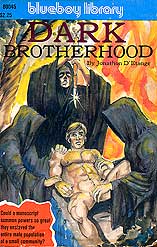 But overall the stories still give the air of one who is trying to show
the positive side of evil. All three stories have the main gay male
character being raped, and most secondary gay characters are killed
off. But, a little slack must be provided here, after all what would
the field of horror be without a little loss of life in secondary
characters? In The Gay Haunt, we see
a gay man who is so fed up with being gay that he 'becomes straight',
only to have his gay friends seduce him back to his former state of
queerness, partially by raping him.
But overall the stories still give the air of one who is trying to show
the positive side of evil. All three stories have the main gay male
character being raped, and most secondary gay characters are killed
off. But, a little slack must be provided here, after all what would
the field of horror be without a little loss of life in secondary
characters? In The Gay Haunt, we see
a gay man who is so fed up with being gay that he 'becomes straight',
only to have his gay friends seduce him back to his former state of
queerness, partially by raping him.
The self-hating undercurrents continue during the early 70s in two other
novels; Daemon
by Peter Tuesday Hughes, written in 1972 and
Devil
at China Cove by Jon Dark in 1973. In these, gays are still able to
have relationships and are quite a bit more masculine, but not the most
moral of people. Daemon shows how fragile
gay men can be and how quickly they accept 'gay for pay,' while
DaCC portrays gays as
getting whomever they want, even if they have to drug them.
These books did serve to highlight how tightly intertwined were the concepts
of gays and demons. Demon's Stalk portrayed
gay men as vessels for the antichrist, while Daemon lightened it up
a bit by just making gays willing to sell their souls for power. DaCC
rounded out the trio by showing that gays could somewhat master demons and keep
them at a private seaside resort. While the threadbare plots were different,
the three agreed on one thing, gay men were convenient means to spread
evil.
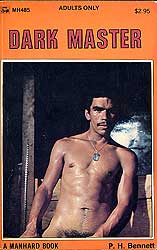 The
Demon Turned Out The
Demon Turned Out
The intermingling of the subjects of gays and demons continues throughout
the 70s. And, as gays became more publicly accepted in the media,
the forewords justifying their existence had vanished. But the subject
matter seemed to show that gay men felt that they were a private
battleground of good and evil, having to fight every step of the
way.
The 'demon' which had been within gay men at last appeared to have been
exorcised. No longer were gays plagued by demons to unleash their
evil against the innocent. But, it also became clear that the demon
was not actually exorcised, since it had never actually existed within.
Instead, the demon was better understood as being forced upon queer-folk
by the community at large, or by smaller 'secret societies' that held
great power.
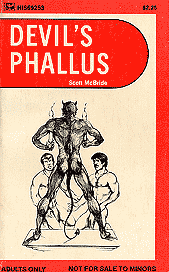 One
such example is Dark Brotherhood
by Jonathon D'Etange, written in 1977, which showed a slice of middle
America trying to coerce gay men into doing evil deeds by drugging them,
brainwashing them and finally possessing them. But, the gays fought back
and won using the power of love.
Dark Master,
a 1978 pulp by P.H. Bennett, doesn't show quite as noble a side of gay-folk as a gay
prostitute is sacrificed to the god Pan after seducing half the
men in a small town. But again, here the evil of the
gay man using and abusing the townsfolk is dwarfed by the EVIL of
society. One
such example is Dark Brotherhood
by Jonathon D'Etange, written in 1977, which showed a slice of middle
America trying to coerce gay men into doing evil deeds by drugging them,
brainwashing them and finally possessing them. But, the gays fought back
and won using the power of love.
Dark Master,
a 1978 pulp by P.H. Bennett, doesn't show quite as noble a side of gay-folk as a gay
prostitute is sacrificed to the god Pan after seducing half the
men in a small town. But again, here the evil of the
gay man using and abusing the townsfolk is dwarfed by the EVIL of
society.
But trends do not change instantaneously, as
Devil's Phallus
by Scott McBride, also printed in 1978 shows us. In this pulp, gay
male sacrifices gay male to his own, personal gods. The men seem to gain
power through the subjugation of each other, and ultimately invoke Kali
as the final solution to their conflict. But, while this is a less than
noble characteristic, it is considered more as a heterosexual male trait
than a homosexual one. So, while the men might be cruel, self-aggrandizing,
amoral monsters, at least they were the same as the rest of society.
Conclusion
The short-lived phenomena of the pulps allow us to see a side of gay
life of the past that isn't normally seen. Freed from the insistence of
publishers to write things only if they'll sell and make money, writers
were able to write what they really felt. But within this short lifetime
of the pulp, there was a definite transition in the thoughts of gays.
What started with an apologetic approach to describing the evil within
us slowly transformed into an understanding that the evil isn't internal,
but rather is foisted on us by society. This understanding was reflected
in the plots, which changed from the need to protect them from us to a
complete reversal in which we are in constant danger from them.
|
